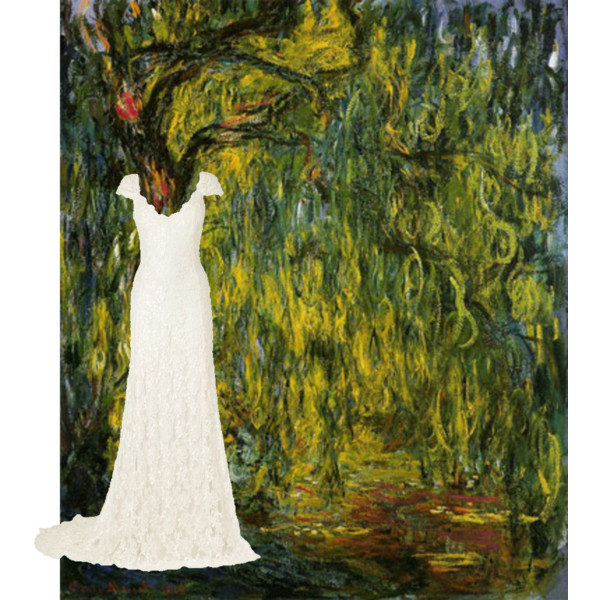For the past three or four years I have been very keen on plant-based mythical creatures, leaning more toward human/plant hybrids than to spirits harbored therein. At the same time this interest has grown, my appreciation of individual trees has intensified. I have even written a story that features a girl/plant hybrid in place of a traditional fairy tale heroine.
Plants are outwardly passive but seething with hidden energies. They don’t crow about their accomplishments or moan in their decline. Plants are the unsung heroes of any era. Think about how tree crazy we would be if there was only one standing tree left on the planet. Well . . . why wait?
Alas, this new love of mine for trees is not really new after all. I remember a very special weeping willow friend from long ago. I lived in a small bungalow with my parents and new sister. A large weeping willow was the centerpiece of the backyard. At three years of age, I was madly in love with the tree. I recall asking my mother if the tree could be mine. She said yes.
I also recall a day when I discovered big girls from the neighborhood climbing the tree. I told them to leave. They said my mother had given them permission. I ran crying to my mother in protest, but she wouldn’t tell the girls to leave. I would not be consoled.
When I was four years old, we moved to another house in a new neighborhood. There were no friendly trees on the property. Across the street was an ancient, brooding forest and a deep gash in the land called a ravine. It was as if I had been moved from a hobbit hole to the edge of Fangorn Forest in one car trip.
One day, my parents took me back to get permission to visit the willow from the new owner of our old bungalow. My tree had been cut down to the stump. The new owner said it was diseased and had to be destroyed. I don’t think I ever got over the loss. If I had, I probably wouldn’t be writing this post.

In honor of my lost weeper, I give you Willow Wife, a Japanese legend.
Willow Wife
Heitaro loved the willow tree that grew close to his hut. As the world judged riches he had none,
but the tree was treasure and temple and company enough for him, and each new season of the year seemed more beautiful than the last. When the wind blew through its branches, no music was finer.
One day the villagers came with their choppers, claiming they needed the wood to build a bridge. Heitaro offered to find them some other wood, if they promised not to touch the Willow. He scoured the land and returned with some wood, and the villagers left, leaving the Willow unharmed.
That night as the moonlight shimmered on its leaves he stood beneath the willow branches and gave his thanks to the gods that the tree had been spared. As he prayed, he saw something move in the shadows. He turned for a closer look and saw a beautiful young woman standing there. He bowed and apologized for disturbing her, backing away, believing she was there waiting for her lover.
Each night after she was there, waiting for her lover, and Heitaro at last realized that it was he himself she came to be with. They were married, and a child soon followed. Every night they prayed together by the willow tree.
One day, the emperor To-Ba ordered that a temple to Kwannon, the goddess of mercy, be built for the villagers.
They wanted the wood of the willow tree, and this time they would not be convinced otherwise. This made Heitaro very sad; however, he realized how blessed he was with his wife and daughter, that he believed he could endure the loss of his willow tree. The villagers began to cut down the willow tree.
The willow wife cried out “Husband, the room is growing dark!” She fell to the ground and covered her face with her hands. Heitaro saw her limbs twisting and turning as though to avoid blows. He found he could do nothing to help her. He and his daughter watched as the willow wife lay dying. When the last blow on the tree was struck, he was alone with his daughter.
Adapted from “Myths of the Sacred Tree” by Moyra Caldecott.
Based on a Japanese folktale, retold by Iyanaga Mitsuyo, and quoted in Meinrad Craighead, The Sign of the Tree: Meditations in Images and Words.


4 responses to “Willow Wife”
Definitely not the “happily ever after” type of tale we’ve become accustomed to, but a much richer story. Thanks for sharing.
Thanks, Dianne. We need happily ever afters, too, but not all the time. I suppose timing is everything, when you think about it.
Lovely post and beautiful story. You certainly shared your love of trees with Tolkien, and one remembers also the death of the wood nymph in ‘The Last Battle’.
I have a willowtree in my garden!
Thanks, Katherine. It’s an honor for me that someone who writes as beautifully as you do sees beauty in my story.